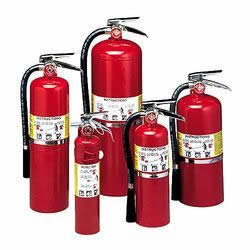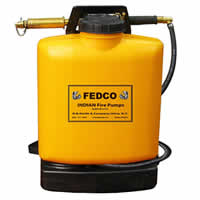Having fire extinguishers, as shown in Figure 1, in your home can easily be a life or death decision. The problem that many homeowners face is that the fire extinguisher industry has many classifications for fire extinguishers as there are many different types of fires. It is important for you to understand the differences before you make your purchase.

Figure 1 - Fire extinguishers
Fire experts and fire departments generally recommend that at a minimum homeowners should have appropriate fire extinguishers in the kitchen, which is the number one location where fire starts in a home, workshop, utility and furnace room and the garage.
Fire classifications:
There are five different types of fire classifications and each is designated by a letter and a geometric symbol.
Table 1
| |||
Fire |
Types of materials that the class can extinguish |
Geometric |
International |
A |
trash, paper, cardboard, most plastics, wood, cloth |
 |
 |
B |
gasoline, grease, oil, kerosene, other combustible |
 |
 |
C |
electrical apparatus, wiring, electrical devices, load |
 |
 |
D |
magnesium, potassium, sodium, titanium and other |
 |
|
K |
cooking oils, fats |
 |
|
Many fire extinguishers will have multiple ratings. As an example you may find a fire extinguisher marked as ABC
, this means that it can effectively extinguish fires of materials in any of the A, B and C categories.
There are basically three types of extinguishing products used within fire extinguishers
Water
Extinguishers filled with water come in two styles, those that have to be hand pumped, as shown in Figure 2, with air in order to force the water out of the canister in a similar manner to a weed sprayer and those that are pre-charged with pressurized air called APW (air-pressurized water) fire extinguishers.
Water should only be used on Class A fires; paper, cardboard, most plastics, wood and cloth. Using water to extinguish an electrical or combustible metals as the water sprayed on the fire will spread the fire.

Figure 2 - Hand pump water fire extinguishers
Dry Chemicals
There are two types of dry chemical fire extinguishers
- Those filled with sodium bicarbonate or potassium bicarbonate and pressurized with nitrogen are used for Class B and C fires.
- Those filled with monoammonium phosphate which is used for Class A, B and C fires.
The primary problem with this type of fire extinguishers is that they leave a corrosive residue which can do more damage than the fire. This residue must be cleaned up immediately after the fire to prevent additional damage.
Monoammonium phosphate leaves a yellow sticky residue that may damage electrical apparatus and devices.
Carbon Dioxide (CO2)
CO2 fire extinguishers are primarily for Class B and C fires. Carbon dioxide is a non-flammable gas that replaces the oxygen in the fire.
While dry chemical has the advantage that it leaves a layer of chemicals over the fire which in most cases will prevent the fire from flaring up after it appears to be burnt out, the layer of chemicals can damage the items that it was sprayed on.
CO2 fire extinguishers do not leave any residue on the item, however it is more likely to have a fire re-ignite after the use of the CO2 because there is no fire retardant chemicals left behind.
Some fire extinguishers will also have numbers beside the letters. The number indicates the square foot area that that fully charged fire extinguisher should extinguish of the specified Class of fire, in the hands of someone trained to use a fire extinguisher!
As an example, you may see a fire extinguisher that is rated 3-A, 10-B, C. This would signify that the fire extinguisher can put out a Class A fire that is no larger than 3 square feet or a Class B fire that is no larger than 10 square feet. Class C never has a square foot designation.
Note: Any fire extinguisher that is pressurized must be inspected at regular intervals to ensure that the unit still has pressure and/or that the chemical inside the fire extinguisher is still able to put out a fire. Annual fire extinguisher inspection and recharging is a must!
